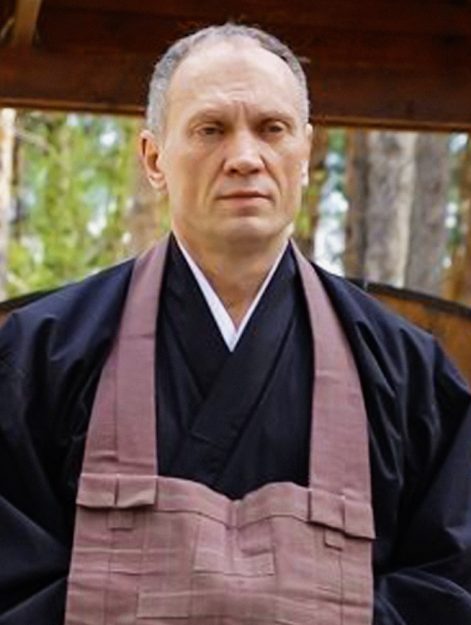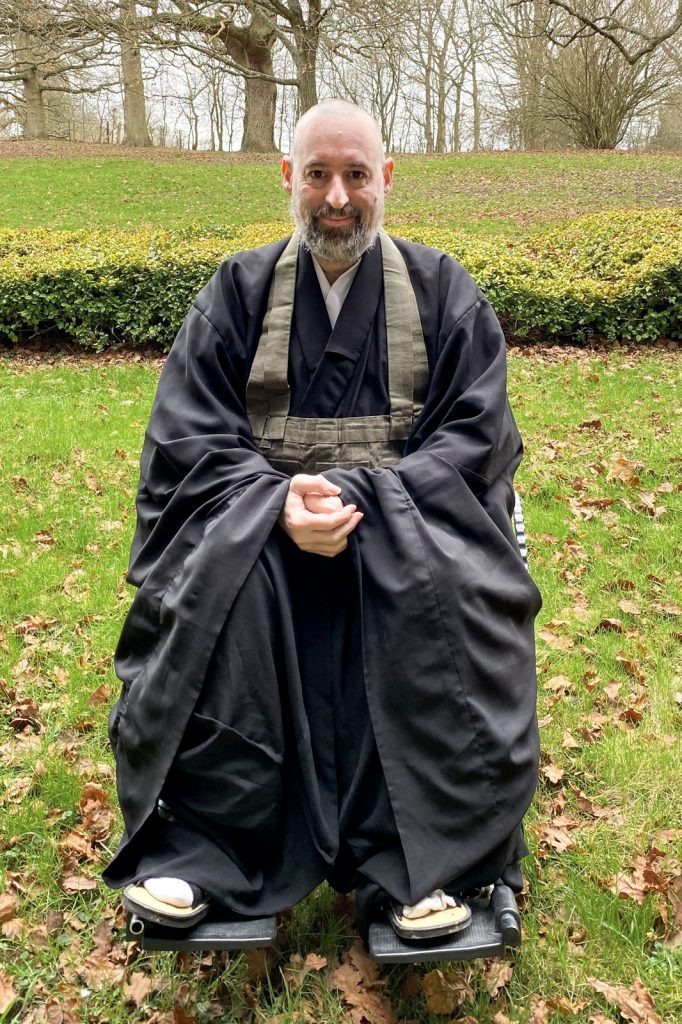Christopher Jinkan Powers had always harbored dreams of becoming a priest. But when he was diagnosed with stage IV cancer in 2016, he feared he would have to abandon his aspiration. “I had already had two open-heart surgeries, and because of the cancer I was mostly bedridden,” he told Tricycle. “I couldn’t go to a temple, let alone ordain.” Looking for a way to continue his practice while in the hospital, he began to sit with Treeleaf Zendo, an online Soto Zen community. As he became more deeply engaged in sangha life, he worked with his teacher and Treeleaf’s founder, Jundo Cohen, to develop a plan for ordination. For the past few years, Powers has served as a novice priest at Treeleaf, sometimes leading ceremonies from his hospital bed as he receives chemotherapy.
Founded over a decade before the COVID-19 pandemic normalized online retreats, Treeleaf has been at the vanguard of virtual Buddhist practice. Cohen formed the community in 2006 as a practice space for people who could not leave their home because of illness or disability. Soon, though, the sangha expanded to include practitioners around the world who couldn’t attend in person because of schedules, geography, natural disaster, or war.
Over the past decade, Treeleaf has ordained several of its members who, like Powers, demonstrate dedication to the dharma but are unable to pursue traditional monastic training. This year, the organization is piloting the first formal nonresidential path to Soto Zen ordination. Called the Monastery of Open Doors, the program is designed for committed Zen practitioners whose circumstances prevent them from participating in residential training.
One novice priest, Sergey Washin Tsarenko, lives in Odesa, Ukraine, where the closest Zen center is 500 kilometers (311 miles) away. After meditating without a community for a couple of years, he joined Treeleaf in 2014 and eventually ordained with Cohen in 2019. When Russia invaded Ukraine in February 2022, Tsarenko was determined to continue his priest training. “I feel I need to be connected to the sangha more than ever,” he wrote. Even during curfews he continues to host daily sits each morning so that people from around the world can practice together. “This would not be possible without Treeleaf.”
Kokuu Andy McLellan began practicing Buddhism in 1997 after he was diagnosed with myalgic encephalomyelitis, or chronic fatigue syndrome. Because of his illness, it is difficult for him to leave his home, so he cannot participate in residential monastic training. In 2017, he received shukke tokudo, or novice ordination, and he has been helping Cohen develop the Monastery of Open Doors to support others who hope to deepen their practice but face similar physical challenges. “There shouldn’t be one pathway to being a priest,” McLellan says. “We’re trying to open up alternative paths for those who can’t go the traditional route. If you’re chronically ill or living with a disability, that is another form of training. Through your illness, you learn to cultivate compassion and understanding of suffering without being in a monastery.”
Cohen agrees, noting that “illness and other hardships may be life’s most powerful koan, and a hospital bed or wheelchair can be a monastery.” In collaboration with the novice priests, he has worked to build an awareness of illness and disability into every aspect of training, including how students learn Zen liturgy, Buddhist history, ethics, and pastoral care.
“If you’re chronically ill or living with a disability, that is another form of training.”
At Treeleaf, as in most monastic training programs, novice priests are expected to lead sits and ceremonies for the community. But at the Monastery of Open Doors, they also learn how to adapt components of each ceremony so that all members have a way to participate regardless of the physical challenges they may face. Because many members have limited mobility, priests have developed ways to perform rituals while seated or, like Powers, while lying in a hospital bed. “We want to show that even if you’re disabled or chronically ill, you can still practice,” McLellan says. “And not only can you practice, you can ordain.”
McLellan and Powers have worked together to find ways to preserve the reverence and sincerity of ritual acts while reducing the physical effort involved. For instance, many ceremonies involve full prostrations with the forehead brought all the way down to the floor, but this can be difficult, if not impossible, for sangha members. Now, they have the option of lifting a bowing cloth, or zagu, up to their head instead. In addition, Powers developed ways to don the kesa, the ceremonial cloth that symbolizes the Buddha’s robes, so that the movements require less physical strain and the wearer’s arm is left open for IV medications.
Soto Zen practice also emphasizes the importance of seated meditation, but the traditional seated posture isn’t always accessible to Treeleaf’s members—some need to recline during zazen, especially during longer meditation periods. To normalize lying down as an acceptable meditation position, Cohen began referring to the posture as “lion’s pose,” recalling the iconography of the Buddha reclining in his final days as he prepared to enter parinirvana. During Treeleaf’s annual retreats, all members recline for some of the meditation periods, regardless of their ability. As Cohen noted, “It doesn’t matter if you have perfect posture. It’s a question of what your body needs.”
Like Cohen, McLellan feels that it is important to change the narrative around what meditation practice should look like. When he meditates with Treeleaf, he often sits with his wheelchair in the camera frame so that others living with chronic illness can see that they are not alone. “We like to get images out there of people in wheelchairs practicing with the same sincerity and love to show that disabled people have a place in the dharma too,” he told Tricycle.
Treeleaf is committed to showing that people with disabilities have always had a place in the dharma. When novice priests learn about Zen lineage, they also learn the stories of people throughout Buddhist history who dealt with illness and physical challenges. This aspect of training was spearheaded by Powers and McLellan, who developed a “differently-abled ancestor ceremony” as a means of increasing the visibility of people with disabilities in the history of Buddhist practice. During retreats, the whole sangha chants the names and stories of these individuals, honoring “those who may have been met by exclusion or fear, those for whom the path was filled with obstacles and barriers, those for whom entrance was so often denied.” The names of these figures are included in the lineage charts that members receive when they take the precepts or ordain.
In addition to studying Zen liturgy and history, novice priests learn how to be supportive members of their community, both within Treeleaf and beyond. “Today, Zen priests have become more like ministers,” says Cohen. “This is beyond zazen. Modern Zen clergy need to know how to respond to sangha members’ crises and concerns.” To this end, priests complete courses in pastoral care, grief counseling, and healthy boundaries, and receive guidelines on when to refer someone to a mental health professional.
McLellan has found pastoral care to be the most meaningful part of his role as a priest. Outside of Treeleaf, he moderates online support groups for people living with chronic illness. “One thing I’ve learned from these groups is how many people out there feel scared and alone,” he says. “If you can just listen and be there for someone, it can make a huge difference.”
For Powers, too, service forms the heart of his work as a priest. Following his open-heart surgery and cancer diagnosis, he began volunteering at his local hospital, providing emotional support and guidance to people facing new diagnoses or complex procedures. A self-proclaimed “big-time nerd,” he also runs Dungeons & Dragons nights at the public library in his hometown of Fresno, California to help kids with intellectual disabilities learn math. “Being a priest means being of service,” Powers believes. “And it’s not just service to our sangha but service to the sangha of the whole world.”

Tsarenko originally sought ordination for this very reason. Through Treeleaf, he leads weekly meditation sessions called “Sitting for Peace,” where individuals from around the world come together to chant the Heart Sutra in English, Ukrainian, and Russian and dedicate their practice to those injured in the war.
“Zen practice is difficult even under normal wordly conditions,” Tsarenko reflects. “In times of war, it is even more difficult because we are constantly under threat. Sometimes we enjoy silent days where there are no attacks. But other days are full of grief because we lose people. So how do we stay balanced? It all starts from zazen. Zazen is the core of our practice. It’s the marrow in our bones. So we sit zazen, and we try to enter deep samadhi [meditative concentration] and generate compassion. Then we get up from the cushion and try to bring this compassion into the world.”
After leading online sits each morning, Tsarenko volunteers at food distribution centers, packaging resources to send to the latest “hot areas” impacted by attacks. He also plants trees by the seaside with a team of volunteers. To date, they have planted and cared for over 1,500 trees. He sees this as fundamentally connected to his role as a priest: “In our practice, we care about all sentient beings. Trees are also sentient beings, and they have a lot to teach us.” Particularly now that bombings have ravaged much of his country’s landscape, Tsarenko feels more committed to planting trees than ever. “Even in war, we can’t forget about beauty.”
Cohen believes that these types of service, though untraditional, are valid forms of training and help priests cultivate wisdom and compassion in the context of their everyday lives. “The point of the Monastery of Open Doors is to train good priests, no matter what winding road gets them there,” he says. “Many of our priests can’t go on ango, the traditional three-month residential retreat required for ordination. But another kind of ango is to be in a battlefield helping load trucks with food or to be nursing your dying spouse at their bedside. That is Zen training. That is abiding with the great question of life and death.”
Cohen acknowledges that Treeleaf’s approach is unconventional, and he still encourages those who are able to pursue residential training to do so. “If every priest were trained like we train our priests, it would be a disaster,” he jokes. “We would lose all the traditions that can be taught only in a residential setting. But there’s room for all of us: the Western monasteries, the monasteries in Japan, the hermits in their caves, and now, the Monastery of Open Doors. We have a place too.”
Thank you for subscribing to Tricycle! As a nonprofit, we depend on readers like you to keep Buddhist teachings and practices widely available.
